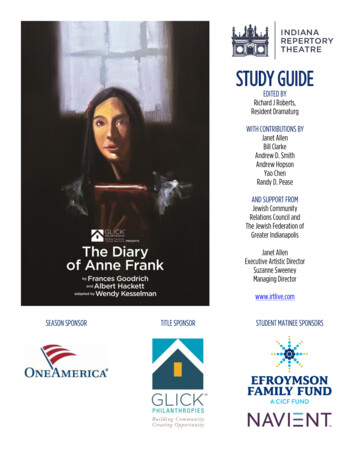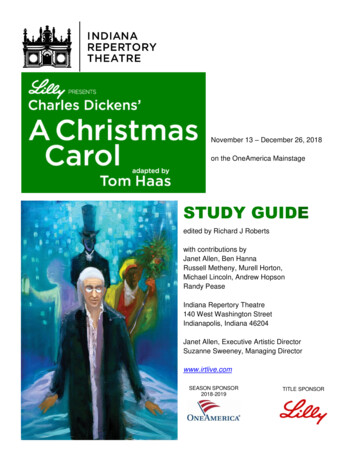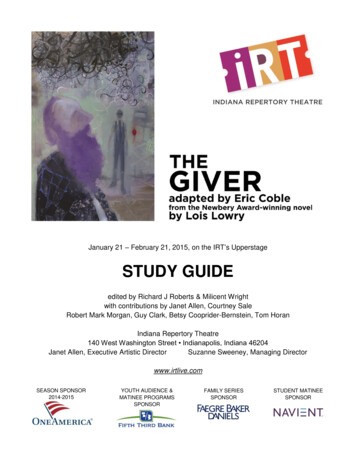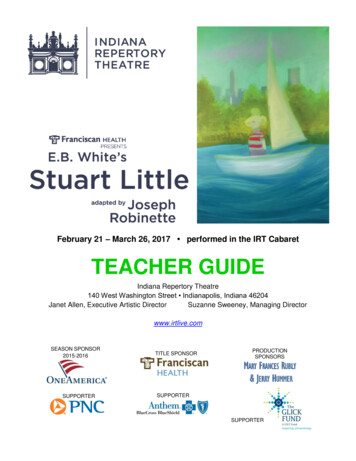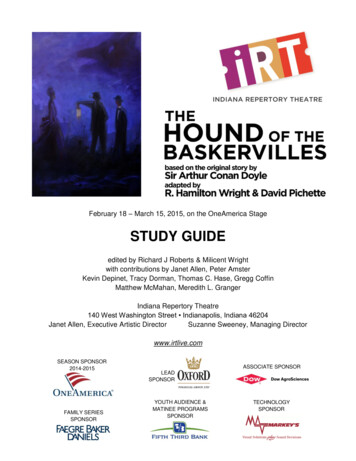
Transcription
February 18 – March 15, 2015, on the OneAmerica StageSTUDY GUIDEedited by Richard J Roberts & Milicent Wrightwith contributions by Janet Allen, Peter AmsterKevin Depinet, Tracy Dorman, Thomas C. Hase, Gregg CoffinMatthew McMahan, Meredith L. GrangerIndiana Repertory Theatre140 West Washington Street Indianapolis, Indiana 46204Janet Allen, Executive Artistic DirectorSuzanne Sweeney, Managing Directorwww.irtlive.comSEASON SPONSOR2014-2015FAMILY SERIESSPONSORASSOCIATE SPONSORLEADSPONSORYOUTH AUDIENCE &MATINEE PROGRAMSSPONSORTECHNOLOGYSPONSOR
2The Hound of the Baskervillesbased on the original story by Sir Arthur Conan Doyleadapted by R. Hamilton Wright & David PichetteJoin Sherlock Holmes and Dr. Watson as Baker Street’s fabled detective duo investigate a deadlythreat to the heir of the Baskerville estate. Will Victorian London’s keenest mind deduce the sourceof the monstrous mongrel before it claims another victim? Family secrets, a haunted hound,romance, and mysteries abound in Sir Arthur Conan Doyle’s timeless tale of supernaturalsuspense.Estimated length: 2 hours, 45 minutes, including 2 intermissionsRecommended for students in grades 6 through 12.THEMES, ISSUES, & TOPICSThe writings of Sir Arthur Conan DoyleFolktales and the supernaturalMystery conventions such as the “red herring”Student Matinees at 10:00 A.M. on February 24 & 25, March 4, 10, 11, & 13ContentsDirector’s NoteArtistic Director’s NoteDesigner NotesSir Arthur Conan DoyleDartmoorSherlock & His PeersForensicsThe Illustrious ClientsHolmes’s Only ViceIndiana Academic StandardsResourcesBefore Seeing the PlayQuestions, Writing Prompts, ActivitiesVocabularyWorks of Art – Kyle RagsdaleGoing to the Theatre3468101214161819202425303839Education SalesRandy Pease 317-916-4842rpease@irtlive.comPat Bebee 317-916-4841pbebee@irtlive.comOutreach ProgramsMilicent Wright 317-916-4843mwright@irtlive.com
3The Unknownby Peter Amster, Director”It’s out there, and it’s going to get you.” This is thetheme of many ghost stories: using the unknown as atool of terror. And nobody did it better than Sir ArthurConan Doyle in The Hound of the Baskervilles, perhapshis most popular and successful Sherlock Holmes tale.(Doyle’s only possible rival in that contest might beEdgar Alan Poe, to whom Doyle pays homage in theHound.). All the ingredients are here: a sinister cityhiding a murderer; a remote village where anotherdemented murderer is on the loose; a bleak countrysidewhere one false step can be your last, where nobodywill hear your screams. Add a giant monster of a firebreathing dog—once thought to be only a myth, but nowmysteriously tangible—frightening the locals (and us).The result is delicious terror.Actor-playwright-producer William Gillettewas a central figure in last season’s TheGame’s Afoot, directed by Peter Amster.The success of the Hound as a practically perfect murder/mystery/ghost story is validated bythe number of movies, TV shows, graphic novels, and stage adaptations that it has spawned—including a very funny play by the same folks who wrote The 39 Steps (which I hope you sawhere a few years ago). And now, here’s a new Hound, dreamed up by some clever fellows inSeattle, that takes every advantage of live theatre and stagecraft to weave its spell and scarethe daylights out of us.But there’s more! This new adaptation makes some small but significant alterations in thetelling of the story. Yes, Holmes and Watson are still here, arguing, helping, rescuing, andadmiring each other. (In the Hound, actually, Holmes absents himself long enough to giveWatson some serious stage time, which Watson has always wanted. And deserved.) Ouryoung hero is still dashing (and Canadian); and the cast of suspects is still interesting,complicated, and, well, suspicious. But the women in our play have been given more stagetime and greater agency than the novel allowed them. Purists may sniff—they often do—butDavid Pichette and R. Hamilton Wright’s new adaptation enhances the original, not only givinga more active voice to the women in the story, but adding a few surprises along the way (donot tell your friends).At all events, I hope you enjoy this telling (and showing) of The Hound of the Baskervilles. Andif we do our jobs well, I hope you will be impelled to go back and read the book (it’s short) andappreciate its artistry. And ours.
4Our Continued Fascination with Holmesby Janet Allen, Executive Artistic DirectorMost anyone who converses in the English language can identify Sir Arthur Conan Doyle asthe mastermind behind one of the great masterminds of all times, Sherlock Holmes. But Doylewas also a practicing physician, a spiritualist, a politically active reformer, and a man of variedliterary pursuits. In fact Holmes became, for Doyle, something of a nemesis. In 1891, ten yearsbefore he penned The Hound of the Baskervilles, he wrote to his mother: “I think of slayingHolmes . and winding him up for good and all. He takes my mind from better things.” Hismother responded, “You won’t! You can’t! You mustn’t!” Savvy capitalist that he was, Doylehiked his price, hoping that publishers wouldn’t bite. But they did, and as a result, Doylebecame one of the best-paid authors of his time.Holmesiana has certainly re-established itself as a cultural obsession. Thanks in no small partto the TV series Elementary (in which Dr. Watson is the thrilling Asian American actress LucyLiu) and the BBC One series Sherlock (in which the dashing English actor BenedictCumberbatch creates a Holmes that is at once sexy and something of a bedeviled savant),Holmes has reentered popular discourse with a vengeance. The Robert Downey Jr./Jude LawSherlock movies prove that Holmes can appeal to a mainstream audience with sex appeal, wit,massive special effects, and violence. All these, combined with our apparently unquenchabledesire for more CSI shows, create a fertile ground for stage adaptation.The IRT’s production of The Hound of the Baskervilles featuresMarcus Truschinski (left) as Sherlock Holmesand Matthew Brumlow (right) as Dr. John Watson.
5The Hound of the Baskervillesnot only tops lists of Holmesfavorites, it has consistentlyremained in the list of 200 “BestReads” of all English languagenovels. It has many elements thatcontribute to its timeless appeal:The mythic allure of anapparently supernatural beast,the resurrection of an old familycurse, the romantic setting of themoors, the multiple layers ofcovered identity, and the tautprogression of a crime thrillercombine into a mentally engagingand emotionally thrilling ride.Give that recipe to a couple ofsavvy actor-adaptors, and theresulting confection is bound tohold delight!We love this adaptation’snuance. Onstage we can deepercharacter development than doesfilm, where acting detail is oftenedited out in favor of specialeffects and visual storytelling. Welike very much that thisadaptation contains humorwithout being a send-up. Many ofthe current stage adaptations ofHolmes’s exploits are decidedlyThe first edition of the novel, published in 1901.tongue in cheek, which ultimatelydefangs the thriller aspects of the pieces. This adaptation honors Doyle’s original intentionswhile craftily deepening some of the character relationships.We’ve put the play in the capable hands of Peter Amster—who has deftly directed a greatmany projects in this genre for us—and a cast of exciting actors from all over the Midwest. Ihave no doubt that the outcome will satisfy the most sophisticated and knowledgeable Holmesenthusiast, as well as the ninth grader encountering Doyle’s artistry for the first time. Thegame’s afoot!
6Beyond Baker StreetKevin Depinet Scenic DesignerHow do you devise a world that so many people have imagined and dreamed about for morethan a century? Well, we wanted to leave a big portion of that vivid environment up to theviewer’s personal imagination. A few specific pieces of Victorian architecture and thesuggestion of the treacherously rocky moors help to signify the creative landscape this playtakes place within. With the help of Sir Author Conan Doyle, we hope to take you on anextraordinary journey that is sure to captivate and engage your imagination!Preliminary drawing of Act 1, Scene 1 (detail), by designer Kevin Depinet.Thomas C. Hase Lighting DesignerI love Sherlock Holmes. As a boy I read every one of the adventures many times over. Themystery of the stories and the solutions using deductive reasoning and clues fascinates me.It’s not only the mysteries, though; but also the time and place where they are set: VictorianEngland, a world full of the change of the Industrial Revolution. Visually what fascinates me inthis world is the half-light, the shade and shadows that it embodies. A world of absolutecontrasts between darkness and light. I am eagerly looking forward to making this world comealive on the IRT stage.
7Tracy Dorman Costume DesignerThe Hound of the Baskervilles is a play that is greatfun for a costume designer because it begins with agroup of nine actors who are each asked to playnumerous characters. Since it’s a Sherlock Holmesmystery, we already know that disguise plays a partin the plot. In this play, in particular, there are anumber of characters who are red herrings. A largepart of the design process was creating the worldthrough the characters who populate it—the Londonstreet scene and the village of Grimpen, for example.We set the play in 1889, so we’re at the height ofVictorian England. In general I wanted the palette tobe dark and textural, to set the tone of suspense.Costume renderings for Sherlock Holmes (above)& Beryl Stapleton (right) by designer Tracy Dorman.Gregg Coffin ComposerWhen Peter and I began our discussion about themusic in Baskervilles, we kept returning to one word:cinematic. The score for the 1959 Peter Cushing–Christopher Lee movie version was composed byJames Bernard, whose non-conventional use of thestring section predated Bernard Herrmann’s Psychoscore by five years. Both men worked extensively inthe field of cinematic horror scores, and it’s theirmusical ideas that I’m building on as I compose themusic for this IRT production.
8Sir Arthur Conan Doyle“It is an old maxim of mine that when you have excluded the impossible,whatever remains, however improbable, must be the truth.”—Sherlock Holmes,“The Adventure of the Beryl Coronet”Scottish physician and writer Sir Arthur Conan Doyle was born in 1859 in Edinburgh, Scotland,and educated at a Jesuit preparatory school in Lancashire, England. He studied medicine atEdinburgh University, where he was inspired by the brilliant deductive skills of his mentor,Joseph Bell. While in school, Doyle worked as a ship’s doctor and later ran his own practice inPortsmouth, England.During these years of study andpractice, Doyle wrote and submittedseveral short stories to the literarymagazines of the day. In 1887Doyle first penned his most famouscreation, Sherlock Holmes of BakerStreet. By 1891, Holmes storieshad become a fixture of the StrandMagazine.Other fictional detectives hadappeared before Holmes, includingcharacters created by Edgar AllenPoe (“The Murders in the RueMorgue”) and Emile Gaboriau(“L’Affaire Lerouge”). But Holmescaptured the public imagination likefew other literary figures have everdone. Doyle himself, however,quickly became tired of his creationand killed him off in “The FinalProblem” in 1893. Popular demandprevailed, and Doyle revivedHolmes eight years later in TheHound of the Baskervilles.Ultimately, Doyle wrote a total offour novels and 56 short storiesfeaturing Sherlock Holmes.
9Sir Arthur Conan Doyle with his children.From 1899 to 1902, Doyle served as a physician in the Boer War. Upon his return, he wroteThe Great Boer War (1900) and The War in South Africa: Its Causes and Conduct (1902), forwhich he was knighted.Although Holmes might be considered the literary icon of empiricism, Doyle was profoundlyinterested in spiritualism. This irony cultivated many of Doyle’s mystic beliefs, which includedfairies, psychic powers, and communication with the dead. He wrote several books on thesubject, including The Coming of the Fairies (1921), The History of Spiritualism (1926), andThe Edge of the Unknown (1930), where he argues that his friend Harry Houdini hadsupernatural powers.Doyle died in 1930 from heart disease at his home in Sussex. The first of many SherlockHolmes societies was founded in 1934, and such organizations still actively debate the finerpoints of the detective’s work. Whole books have treated Holmes and Watson as actualhistorical figures, filling in gaps and calculating dates from clues in the stories. More than 70actors have portrayed Holmes in some 250 films. The IRT’s production of The Hound of theBaskervilles is only the latest element in our ongoing fascination with Sir Arthur’s indelibledetective.—Matthew McMahan
10The Mystery and Allure of Dartmoor“Over the green squares of the fields and the low curve of a wood there rose inthe distance a gray, melancholy hill, with a strange jagged summit, dim andvague in the distance, like some fantastic landscape in a dream.”—Dr. Watson’s first view of the moor in Conan Doyle’s novelThe Hound of the Baskervilles begins, as do many of the Holmes tales, in London at 221BBaker Street. But most of the story takes place in Dartmoor, a sparsely populated area ofmoorland located in the county of Devon in the West Country, the triangle of land that pointsout from the southwest corner of England between Wales and the English Channel. At 368square miles, Dartmoor is the largest open space in southern England, preserved since 1951as national park land.Dartmoor extends across a large expanse of granite bedrock covered with low-growingheather, bracken, gorse, and wild grasses. The rolling hills are punctuated by the occasionalhawthorn or rowan tree. The wide moorland is capped with many exposed granite hilltopsknown as tors: large, free-standing rock outcroppings that rise abruptly from the surroundingslopes. Cattle, ponies, and sheep graze the open fields, while wild rabbits and foxes share thevegetation with a large variety of birds and butterflies. The weather is often cloudy andovercast; Dartmoor is one of Great Britain’s heaviest rainfall centers.Several torscropping outthrough thehills ofDartmoor.
11A mire in Dartmoor.The vast, openlandscape ofDartmoor is dottedhere and there withlonely stone cottagesand farmhouses, andeven a few smallvillages. ConanDoyle’s BaskervilleHall, Merripit House,Lafter Hall, andGrimpen are allfictional places—butthey were inspiredby real locations inDartmoor, and eachembodies the uniquespirit of the place.Dartmoor is rich in antiquities and archaeology, including dozens of prehistoric standingstones, hut circles, and ancient stone tombs. With its bleak weather, scattered populace, andbarren hills, no wonder Dr. Watson calls Dartmoor “ this most God-forsaken corner of theworld.” But he goes on to say that, “The longer one stays here the more does the spirit of themoor sink into one’s soul, its vastness, and also its grim charm.”Central to the novel is the Great Grimpen Mire, thought to be inspired by Dartmoor’s real FoxTor Mire. A mire is formed when rainfall accumulates on the granite shelf, leading to the growthof moss, which decays and forms thick layers of peat. The peat absorbs rainwater quickly anddistributes it slowly, so the moor is rarely dry. In areas where water accumulates, dangerousbogs or mires can result. Some of these, topped with bright green moss, may look and evenfeel solid enough, but the soft ground can easily shift. Fox Tor Mire covers an area of roughly250 acres. In the dry summer, it can be a tranquil place where herds of ponies and cattle grazeupon the lush vegetation. But in wet weather, its landscape is shrouded in mists that hide darkpools of liquid peat that can suck the unwary down to his or her death.Conan Doyle leaves it to the character of Jack Stapleton, a relative newcomer to Dartmoor, totry to articulate its strange appeal: “‘It is a wonderful place, the moor,’ said he, looking roundover the undulating downs, long green rollers, with crests of jagged granite foaming up intofantastic surges. ‘You never tire of the moor. You cannot think the wonderful secrets which itcontains. It is so vast, and so barren, and so mysterious.’”
12SHERLOCK HOLMES AND HIS PEERSWhile Sherlock Holmes may be the most famous detective in all of literature, he certainly wasnot the first. Holmes belongs to a bevy of great sleuths, both professional and amateur, whosetradition spans from the mid-1800s through today. Edgar Allen Poe’s “The Murders in the RueMorgue” is considered by many to be the first detective story; it inspired many mysteries tofollow, including Wilkie Collins’s The Moonstone (1968) and Charles Dickens’s The Mystery ofEdwin Drood (1870). Here are some other notable detectives in the mystery fiction canon:C. Auguste Dupincreated by Edgar Allen Poe (right)introduced in “The Murders in the Rue Morgue” (1841)appeared in three short storiesCredited as the first true mystery detective, Dupinestablished the groundwork on which many literarydetectives are based. His method of deduction wasbased on what Poe terms “ratiocination,” thecombination of scientific logic with artistic imagination.As Sherlock Holmes’s stories are told by Dr. Watson,Dupin’s stories are narrated by a close personal friend;like Holmes, Dupin reveals the final solution first beforeoffering the reasoning behind it. Perhaps in ironichomage to Dupin, in A Study in Scarlet, Holmes callsDupin “a very inferior fellow . very showy andsuperficial.”Monsieur Lecoqcreated by Émile Gaboriauintroduced in The Lerouge Affair (1866)appeared in five novels and one short storyÉmile Gaboriau has often been dubbed the founding father of the modern detective novel. HisMonsieur Lecoq is an agent of the French Sureté, the civil police force in France. He solves hiscases by gathering several minute clues and then drawing logical conclusions that amaze hiscolleagues. He too was considered to be a major influence on Holmes, who calls him “amiserable bungler” in A Study in Scarlet.Hercule Poirotcreated by Agatha Christie (opposite above right)introduced in The Mysterious Affair at Styles (1920)appeared in 33 novels and 54 short stories
13A retired Belgian detective, Hercule Poirot’s primary strategyis to unravel the psychology of both victim and murdererthrough cunning conversation with suspects. It was hismaxim that “in the long run, either through a lie, or throughtruth, people were bound to give themselves away” (Afterthe Funeral, 1953). When Christie’s last Poirot novel,Curtains, was published in 1975, Poirot was the first fictionalcharacter to be given an obituary in the New York Times.Miss Jane Marplecreated by Agatha Christie (right)introduced in Murder at the Vicarage (1930)appeared in 12 novelsMiss Jane Marple is an elderly spinster who often acts as anamateur detective. Although she appears as an innocuousand easily confused old woman, her outstandingunderstanding of human nature and sharp wit allow MissMarple to solve mysteries that stump the local police in her small English village.Perry Masoncreated by Erle Stanley Gardnerintroduced in The Case of the Velvet Claws (1933)appeared in more than 80 novelsPerry Mason is a lawyer whose clients are typically charged with murder. Mason usuallyexonerates his clients by finding the real murderer in the process. The character was also verypopular on television, appearing from 1957 to 1966 in one of television’s most successful andlongest running lawyer series, and in more than 25 made-for-TV movies from 1985 to 1993.below: Raymond Burr as Perry Mason.Philip Marlowecreated by Raymond Chandlerintroduced in The Big Sleep (1939)appears in seven novelsPhilip Marlow is the preeminent figure in a genre knownas hardboiled crime fiction, which features a tough,unfiltered presentation of crime and violence. He is anhard-nosed, wise-cracking, alcoholic private eye who isnot afraid to fight his way through sticky situations.Marlowe was most famously played by Humphrey Bogartin the movie The Big Sleep in 1946.—Matthew McMahan
14From the Detective’s Mouth:On forensic science, its influences, and its mythsDr. John Goodpaster is the director of the Forensic Sciences Program and an associateprofessor of chemistry at Indiana University–Purdue University–Indianapolis. He has an M.S.in criminal justice and a Ph.D. in analytical chemistry from Michigan State University. Hepreviously served as a forensic chemist with the U.S. Bureau of Alcohol, Tobacco, Firearms,and Explosives’ ATF Laboratory in Maryland. Here Dr. Goodpaster talks about the field offorensic science and its influences, developments, and myths.IRT: What is your definition of forensic science?JG: Well, the generally accepted definition is any science applied to the law. So, it is a science,like chemistry, but applied to questions that are legally relevant, involving both criminal andcivil law.In your opinion, what would you pinpoint as the top innovation in the field?Well, obviously DNA was huge. DNA technology came out in the 1980s but continues torevolutionize the way in which we investigate crime. The biggest and most obvious powerbehind DNA is that it can individualize. It can say, “That blood stain was made from thatperson’s blood, to the exclusion of all other people.” The ability to say that with confidence ishuge. And, when you think about DNA, it’s everywhere. You’re whole body is full of it. Sowhenever you leave anything like blood, hair, or anything behind, you’re leaving DNA behind.How old is the practice of forensic science as we understand it today?In my opinion, I would put it back in the late 1800s. That’s when you first saw people trying toindividualize evidence. One thing they tried to do—the precursor to fingerprints—was to usethe actual physical dimensions of a person to keep track of them. That faded out rather quickly,as you can imagine, because of fingerprint technology. The field of fingerprints came alongand people realized taking someone’s fingerprints is a great way to find them later because thefingerprint doesn’t change and its very complex. That was all developing in the late 1800s.
15What are somesteps a youngperson can take tobecome a forensicscientist?First, they needreally solid skills inthe areas of mathand science. Mostforensic scientistsare chemists andbiologists, so thosetwo fields woulddefinitely be good tolook into. But, justabout any area ofscience can lead intothe field. Getting acollege degree ispretty much required,and I would even recommend going on to get a graduate degree. There are many places youcan go to get a degree in forensic science, including IUPUI.Are there any prevalent myths you’d like to debunk?Oh, yes! Because in a TV show they only have 45 minutes to portray certain things, everythinghappens at a really fast pace. A real investigation is much longer, much more drawn out. Forexample, a DNA analysis may take up to two weeks before you can get a result. In anexplosives case, sometimes you can get it done in a day, and other times it may take months.Same thing with hair/fiber exams. The process can take weeks. Second are the resources.The resources you see on TV are far and above what you actually find in real state forensiclaboratories. The government simply doesn’t have the budget that CBS does. A real lab can’tafford the kinds of fancy equipment on those shows, which is too bad.What influence do you think Sherlock Holmes had on the field?Oh, he’s great. I’ve read Sherlock Holmes, and he’s been the inspiration for I think almostevery fictional scientific detective since, especially in the area of trace evidence, finding reallysmall bits of materials and drawing conclusions from that. Ironically, some of the things writtenabout in Sherlock Holmes predated the reality. In one of his books, he talks about a chemicalexperiment that tested whether or not a red substance was blood. At the time, they weren’table to do that, but now we can.—Matthew McMahan
16The Illustrious ClientsThe community of Sherlock Holmes aficionados extends over several continents and manycountries. Perhaps surprisingly, the city of Indianapolis, far from London, is featured in thefollowing tale.In 1894, Arthur Conan Doyle, creator of Sherlock Holmes, visited Indianapolis on a lecturetour. He snapped some photographs from the top of the not-yet-completed Soldiers’ andSailors’ Monument, had dinner with famous poet James Whitcomb Riley, delivered his speech,and departed the next day. In 1923, Sir Arthur returned to Indianapolis and was a guest at theClaypool Hotel at the corner of Washington and Illinois Street. In correspondence, he madeobservations on some of the shortcomings of large cities in nearby states; he describedIndianapolis as “an old friend.” The original manuscript for the introduction to his book Throughthe Magic Door was written on stationery of the Claypool Hotel. Four years after Doyle’s visit,the Indiana Theatre would be constructed mere yards away from the Claypool Hotel.In 1934, columnist and editor Christopher Morley founded the Baker Street Irregulars, still thelargest and best-known Holmes club in the United States. It is the parent organization of manylocal clubs founded since. In 1945, 13-year-old Jerry Williamson of Indianapolis enjoyed adouble feature at the Indiana Theatre: the latest Abbott and Costello film (the reason he was inattendance) and House of Fear, a Basil Rathbone film that was Jerry’s introduction to the worldof Sherlock Holmes. The next year, Jerry founded the Illustrious Clients, a local Sherlocksociety. After thriving for fifteen years or so, the group became inactive. In 1977, following aSherlock Holmes symposium at the University of Notre Dame, Michael Whelan (now presidentof the Baker Street Irregulars) and historian William Lutzholz formed a Holmes club inIndianapolis and revived the name “The Illustrious Clients.” This club survives and thrives tothe present, with a large, active membership, nine meetings each year, and membership opento anyone at least sixteen and interested in Sherlock Holmes.In 1994, Wessex Press, nowWessex/Gasogene Press, now one ofthe leading Sherlockian publishinginterests in the world, was founded inIndianapolis. That same year, theIllustrious Clients of Indianapoliserected a permanent marker at UnionStation (left) to commemorate theone hundredth anniversary of ArthurConan Doyle first visit to Indianapolis.It was the first permanent tribute toDoyle in North America.
17The IRT’s 2008production ofSherlock Holmes:The Final Adventureby Steven DietzfeaturedJonathan Gillard Dalyas Sherlock Holmesand Mark Goetzingeras Dr. Watson.Today, the LillyLibrary at IndianaUniversity ownsSir Arthur ConanDoyle’s originalautographmanuscript of theHolmes tale “TheAdventure of theRed Circle.” ASherlockiansymposium is held in Indianapolis or Bloomington every few years with an impressive line-upof figures from the world of stage and screen and noted scholars lecturing on related topics.The Hound of the Baskervilles is the IRT’s fifth Holmesian production. Ken Ludwig’s TheGame’s Afoot, produced last season, focused on William Gillette, a famous stage interpreter ofSherlock Holmes, and opened with a scene from “A Scandal in Bohemia.” In 2008, the IRTproduced Sherlock Holmes: The Final Adventure by Steven Dietz, and in 1990 Sherlock’s LastCase by Charles Marowitz. In 1982 the IRT produced the world premiere of Operetta, My DearWatson, a musical by then–artistic direct Tom Haas that featured songs by Gilbert andSullivan.The show must go on; the game is afoot.—Meredith L. GrangerMeredith L. Granger has been a member of the Illustrious Clients for 26 years, many of thoseserving as vice president. On various stages around the country he has portrayed Holmes,Watson, Dr. Joseph Bell (Doyle’s mentor and model for Holmes), and Moriarty. Our thanks tohim for this special guest article.
18Holmes’s Only ViceBelieve it or not, the world’s greatest detective was known to use cocaine and opium habituallythroughout the Sherlock Holmes canon. In The Sign of the Four, Watson reports that he haswitnessed Holmes inject himself with cocaine up to “three times a day for many months” torelieve himself of the “dull routine of existence.”While for us, cocaine abuse of this nature would be considered pathologically criminal, inHolmes’s time, drugs were not understood as well as they are today. In fact, drugs were notoutlawed until the first few decades of the twentieth century. Cocaine itself was not banneduntil World War I, when rumors swelled that Germans were selling cocaine to British troupes.Before this, medicines including opiates and stimulants were readily available to everyonewithout prescription. Often times, opium would be used to relieve severe pain, coughing, ordiarrhea. Sigmund Freud used cocaine to treat his family for a variety of ailments, and evenwrote the essay “Über Coca” to promote its effects.Not long after, however, many ofcocaine’s advocates (includingFreud) started recanting theirsupport after evidence of itsdangers became apparent:dangers including addiction,paranoia, heart attacks, infections,and hallucinations.Though Holmes’s drug abuse wasprofound, in “The Adventure of theMissing Three-Quarter” Watsonsays that he had ably “weanedhim from that drug mania whichhad threatened once to check hisremarkable career.” However,Watson also admits that Holmes’saddiction could never be curedoutright: “I was well aware that thefiend was not dead, but sleeping; and that the sleep was a lightone.”—Matthew McMahan
19Indiana Academic Standards Alignment GuideReading – LiteratureRL.1 – Read and comprehend a variety of literature independently and proficientlyRL.2 – Build comprehension and appreciation of literature by analyzing, inferring, and drawing conclusions aboutliterary e
creation, Sherlock Holmes of Baker Street. By 1891, Holmes stories had become a fixture of the Strand Magazine. Other fictional detectives had appeared before Holmes, including characters created by Edgar Allen Poe ("The Murders in the Rue Morgue") and Emile Gaboriau ("L'Affaire Lerouge"). But Holmes captured the public imagination like




